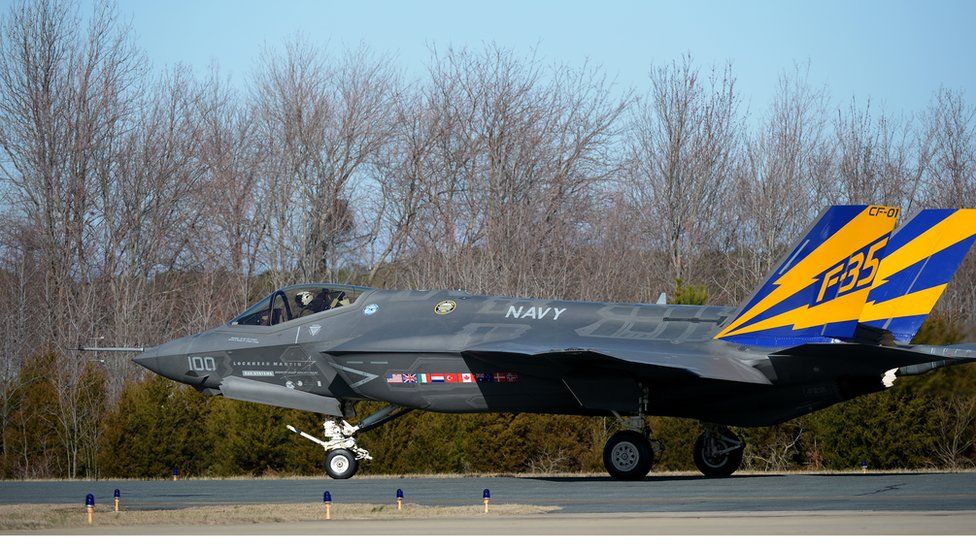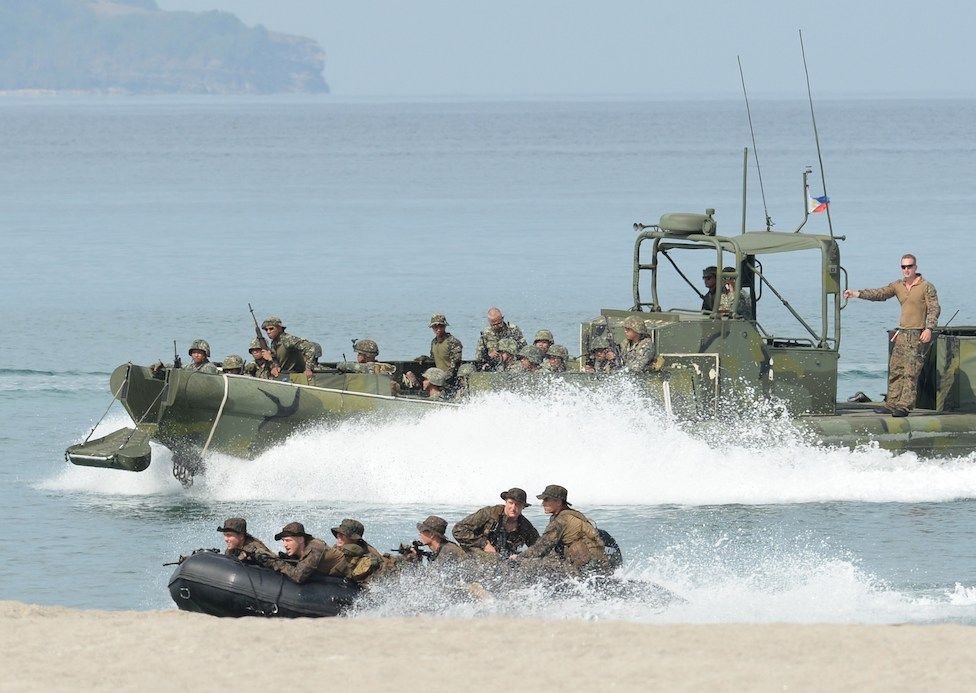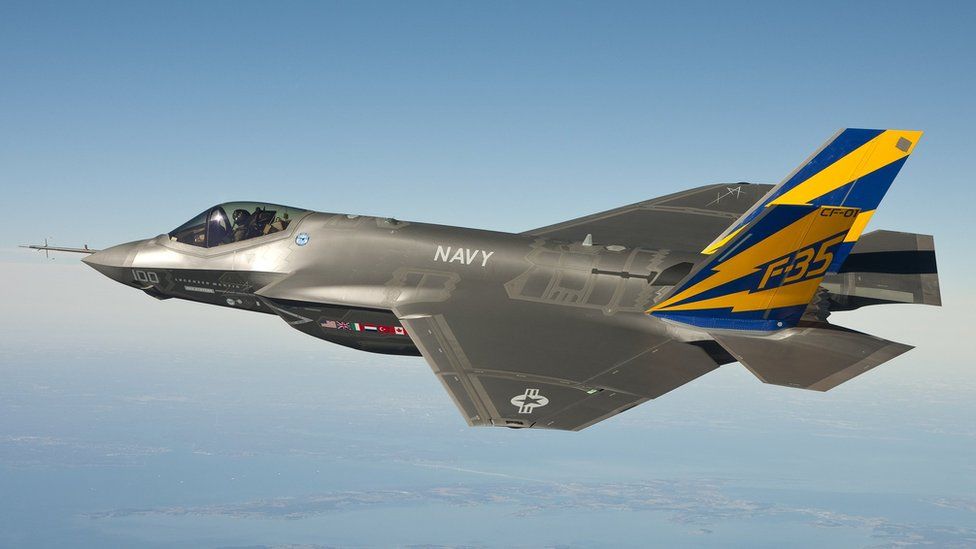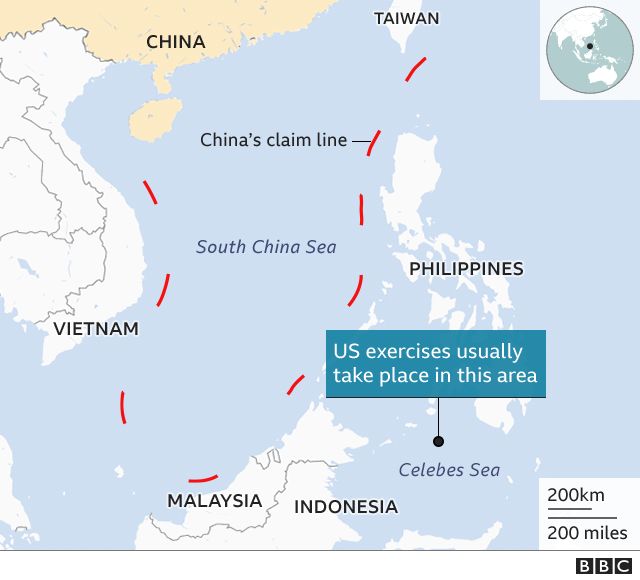 IMAGE SOURCE,GETTY IMAGES
IMAGE SOURCE,GETTY IMAGESA race against time is under way for the US Navy to reach one of its downed fighter jets – before the Chinese get there first.
The $100m (£74m) F-35C plane came down in the South China Sea after what the Navy describes as a “mishap” during take-off from the USS Carl Vinson.
The jet is the Navy’s newest, and crammed with classified equipment. As it is in international waters, it is technically fair game.
Whoever gets there first, wins.
The prize? All the secrets behind this very expensive, leading-edge fighting force.
Seven sailors were injured when the jet came down on Monday after it struck Vinson’s deck during a military exercise.
It is now lying on the ocean bed, but what happens next is a mystery. The Navy will not confirm either where it came down or how long it will take to retrieve it.
China claims almost the entire South China Sea and has increasingly taken steps to assert that claim in recent years, refusing to recognise a 2016 international tribunal ruling saying it had no legal basis.


On Thursday, Chinese Foreign Ministry spokesman Zhao Lijian denied Beijing was after the stricken F-35C. “We have no interest in their aircraft,” he said at a briefing.
Still, US national security experts say Chinese military would be “very keen” to get to the jet. A US salvage vessel looks to be at least 10 days away from the crash site.
That’s too late, says defence consultant Abi Austen, because the black box battery will die before then, making it harder to locate the aircraft.
“It’s vitally important the US gets this back,” she says. “The F-35 is basically like a flying computer. It’s designed to link up other assets – what the Air Force calls ‘linking sensors to shooters’.”
China doesn’t have that technology so getting their hands on it would give them a huge leap forward, she says.
“If they can get into the 35’s networking capabilities, it effectively undermines the whole carrier philosophy.”
Asked if there were echoes of the Cold War here, she says: “It’s all about who’s the biggest dog in the park! This is basically The Hunt For Red October meets The Abyss – it’s a brilliant three-act play.”



What’s so special about the F-35C?


- a network-enabled mission system that allows real-time sharing of information it collects while in flight
- US Navy’s first “low observable” carrier-based aircraft which enables it to operate undetected in enemy airspace
- larger wings and more robust landing gear make it suitable for “catapult launches” from carriers at sea
- has the most powerful fighter engine in the world and it can hit speeds of up to 1,200 mph, or Mach 1.6
- can carry up to two missiles on its wings and four inside



Ms Austen, a former adviser to the US Chairman of the Joint Chiefs and former senior Nato and EU diplomat, said she believes any attempt by China to try to claim salvage rights was them “stress testing” the US.
It comes at a vulnerable and dangerous time following what some perceived as a disorganised and disastrous Afghanistan pull-out, she believes.
There is no doubt China wants this plane, although cyber espionage may mean they already have some knowledge of its interior, layout and workings, says Bryce Barros, a China affairs analyst and security fellow at the Truman Project.
“I think they would want to see actual parts of the plane, to better understand how it is laid out and find its vulnerabilities.”
The US Navy acknowledged in a statement that a recovery operation was under way following the “mishap” aboard USS Carl Vinson.
So how would the retrieval actually work?
A team from the US Navy Supervisor of Salvage and Diving would attach bags to the jet’s fuselage which will then be slowly inflated to raise the wreckage.
This operation will be more difficult if the airframe is not largely in one piece.
The aircraft was likely to have been armed with at least a couple of missiles carried either on its wings or in the internal weapons bay which could also complicate recovery.


There is precedent for these winner-takes-all military cat and mouse games.
In 1974, at the height of the Cold War, the CIA secretly pulled a Russian submarine from the sea floor off the coast of Hawaii using a giant mechanical claw
Two years earlier, the Chinese military secretly salvaged the UK submarine HMS Poseidon which sank off China’s east coast.
And it is widely believed that China got its hands on the wreckage of a secret US “stealth” helicopter that crash-landed in the raid on Osama bin Laden’s compound in 2011.
Mr Barros said: “We are sure the Chinese military got to see the onboard equipment and software then.”
The Guinness World Record-holding deepest successful salvage operation was the raising of the wreckage of a US Navy transport aircraft from the floor of the Philippine Sea in May 2019.
It was some 5,638m (18,500 ft) below the surface,
One other option, of course, is to destroy the jet to stop it getting into the hands of Beijing.
“The easiest thing to do would be to torpedo it!” said one military officer.
But that’s not thought to be an avenue under consideration.
- BBC
